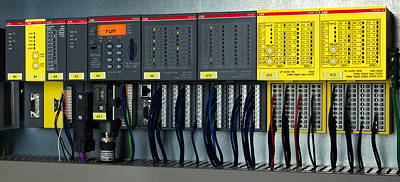- Home » News » Product News
Dual-processor safety PLC simplifies complex applications

ABB has launched a safety PLC which, it says, will speed and simplify the development of safe control systems for complex control applications. The AC500-S PLC has a dual-processor architecture that complies with SIL3/PL e functional safety requirements.
The PLC was first seen at the Hannover Fair in 2011 and since then has been field-tested in ten pilot applications including cranes, mining hoists, automatic guided vehicles, and robots.
The PLC supports Structured Text (ST) programming, as well as graphical function block diagram (FBD) and ladder diagram (LD) programming. This high-level support is said to simplify the development of sophisticated applications requiring complex algorithms and mathematics. A powerful suite of trigonometric functions helps to provide safe control in applications involving complex kinematics – such cranes, hoists and manipulators.
Existing AC500 PLC users can use the new PLC to convert to safety PLC architectures and applications. ABB includes support for programming the safety PLC in its Codesys-based development environments for control, motion, robotics and HMIs.
The safety PLC hardware shares the same look-and-feel as ABB's AC500 non-safety PLC CPUs and I/O modules, as well as having the same dimensions, mounting arrangements and wiring schemes. The two types of module can be mixed, allowing a PLC to perform both safety and non-safety functions. This can reduce the complexity and costs of projects, and opens up the possibility of direct variable mapping and data exchange between safety and non-safety elements in a control system.
ABB has also developed a safety code analyser tool, called SCA, to verify the safety programming rules or guidelines according to IEC 61508-3 under FBD, LD and ST. This tool – thought to be the first of its type – has been certified by TÜV SÜD. The results are documented in a technical report. The tool is said to result in PLC code that is more reliable, better structured, and more easily readable, helping to cut certification efforts and post-release maintenance costs.
The programming editor supports the PLCopen safety library, including all of the standard function blocks used in safety applications, such as e-Stops and two-hand controls. The safety PLC also supports all IEC data types, giving programmers more flexibility.

Unlike some other safety PLCs, the AC500-S has a separate safety processor which can be configured to work even if the non-safety processor is in Stop or maintenance mode, or during an online change. The dual-processor architecture means that users can upgrade the PLC’s performance by plugging in a faster non-safety CPU module.
ABB offers a choice of SIL3/PL e certified safety I/O modules including digital I/O, and an analogue current input module covering 0–20mA (or 4–20mA). This module can be used to measure parameters such as pressure, temperature, position and torque without needing A/D conversion or proprietary electronics. This can simplify the implementation of safety-related control applications such as braking systems in hoists and lifting equipment, and positioning systems on cranes.
To simplify system design, safety-related control modules can be installed as part of the main PLC, or in a remote I/O rack linked using the Profinet/PROFIsafe protocol. Such network-connected control systems save cabling and assembly costs, and avoid interference problems. The I/O modules have built-in power supplies, cutting hardware costs and space requirements compared to some rival PLCs.
The safety PLC modules are available in ABB's XC (extreme conditions) format, allowing users to configure functional safety PLCs that are also rugged and suitable for operating in harsh conditions and extreme climates.





